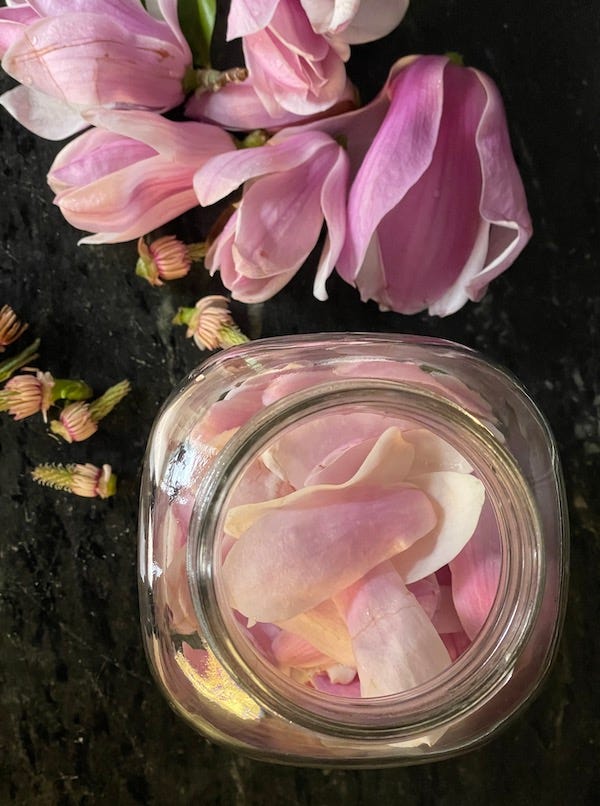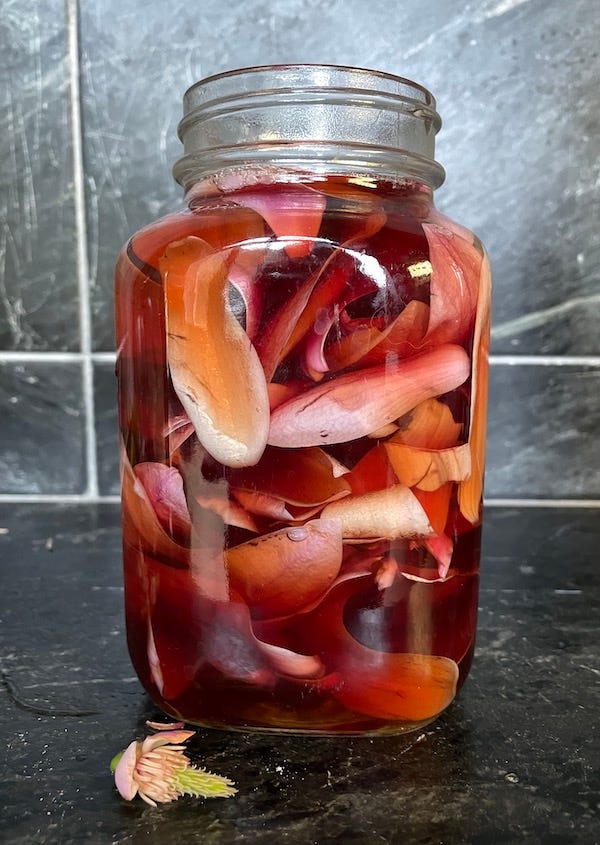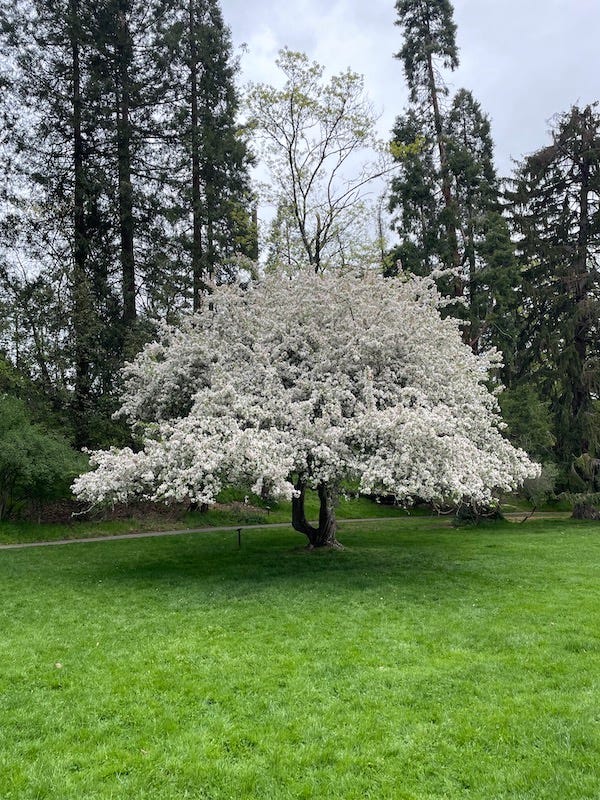I is for...
Inbox, impulsive, intuitive fermentation, inspiration, imposter syndrome, using your imagination to make a blossom shrub
A while back, as happens daily, my inbox fills while I am still slumbering through the predawn hours on the west coast. Once such morning, greeting me, as I cradled my first warm drink of the day, was a call out for judges in the IACP Cookbook Awards Program. In what might be described as impulsive, I, who had plenty of other tasks on my rotating to-do list, filled out the application. In those first moments of the day, potential abounds in my mind. I haven’t looked at what the day actually holds and my mind telling me “That sounds fun” was enough. Right then, the second warm drink hand, with a click my application was submitted. And I proceeded to go about my day and forget about it. A month or so later, another email landed, you guessed right. I’d been selected to participate as a judge. I am not sure if I told Christopher that day, “Um, I did this thing…” or waited until the next email announcing that 30 + cookbooks would arrive on our doorstep. (He is used to the sheepish me; announcing that I jumped into something new without thinking about it too much. Mostly it has served me well...)
I have perused all of the books in stacks occupying a corner of the dining room table, except the last few that arrived today. So far, I have read 11 of them. The first few were the smallest I could find. I wanted to see some progress quickly. Now I am tackling the heaviest ones, I don’t want to be looking at these when I am down to the wire. I am saving the ones I might have bought for last. The fun part is just that. I wouldn’t have looked twice at most of these cookbooks in a bookstore, let alone buy them. They are simply not subjects I would have gravitated toward. The evaluation requires looking at the components of the books and the recipes which has focused my attention on how a recipe is written, or how a cookbook is set up to achieve its goal because I am always looking to improve on what I do.
Deep down, my goal, at least in this aspect of my life, has always been about making fermentation, especially lactic acid vegetable fermentation, second nature for anyone entering a kitchen and wanting to engage in some part of food preparation. After all, one doesn’t need to cook, or even like to cook, to ferment. I believe that fermentation can become as routine, or as intuitive as any part of one’s kitchen practices. It is my hope that in the work that I do, through this missive, live workshops, online courses, and our books I can impart that fermentation is simple and can become something you make as needed and use as instinctually as another ingredient.
When I was in seventh grade our teacher, Mr. Tackett, gave us an assignment, to write out instructions for making a peanut butter sandwich. The day our “recipes” were due he showed up with loaves of white bread, a butter knife, and a big jar of peanut butter. We each took our turn standing in front of the class while he read what we’d written out. We had to follow our own instructions precisely. Many of us, couldn’t get past the peanut butter because we hadn’t indicated to open the jar. Some of us had to spread the peanut butter with our fingers because the knife hadn’t been mentioned. You get the idea, most of us stood in front of our classmates and failed at making a peanut butter sandwich to bursts of laughter. Is your anxiety level going up? I do need to acknowledge what I am describing seems absolutely horrifying, especially at that age. For some reason, it wasn’t, and I was introverted, painfully shy, and had low self-esteem. Somehow, though Mr. Tackett had still cultivated a positive atmosphere we all thought it fun and not horrible. I honestly do wish I remembered how well/not well my instructions were written. I can tell you that it was one of the few school lessons I remember. When I started writing recipes in order to teach people to ferment 30 years later, I thought of Mr. Tackett and tried to make sure that my own proverbial peanut butter jar lid was unscrewed. While we are talking about Mr. Tackett, who honestly scared me a bit (tall, lean, and ancient in my then mind, kind enough but also quite strict) I will also credit him for my discovery and love of biology. I wasn’t a great student. The only other lesson I remember from that year (and in the mere handful that I remember from my entire school career) was one of his. We meticulously went through the growth cycle of embryo chicks. Looking back now, he is probably the most unlikely of my teachers, I would have thought then to have a lasting influence. Thank you, sir.
Turns out I enjoy writing for the purpose of helping people gain a new skill. I’ve personally learned so much from books and I do love the idea that anyone with a library card can seek out a book on whatever it is that inspires them at the moment and learn. From the moment the 10-year-old me read The Diary of Anne Frank, I knew I would write. I would never have guessed it would be about fermenting food. I would have told you I was going to write dark and stormy novels.
Here is where I admit the actual recipe writing part of our books is a challenge for me because my natural state is to cook and ferment intuitively. I operate on what is available and instinct. So, to slow down to pay attention and write down what I am doing in case I would like to repeat it is difficult. I have had to train myself to do this, and it is still an imperfect system. I have learned that I lose my rhythm if I stop mid-dash of this or pinch of that, but I don’t allow myself to leave the kitchen until I have written down and captured an approximation of what just happened. (I have to interject that I love my scale for helping me catch those approximations. Contrary to the initial reaction to a precision instrument requiring specific measurements, I found on the recipe development end it is freeing not to be confined to volume measurement.)
If we (the we being Christopher and whomever I can catch to taste) decide something is worth repeating, then the refinement begins. I can look at those initial notes and weight measurements and find the volume measurements that are close and try variations—with more or less of the flavor-forward ingredients in any particular make. I used to think I needed to hide the fact that my brain worked in this way, that I have to back into the recipe’s measurements. I am a home cook--taught by my grandmother, put into practice by my mother’s disinterest in cooking my senior year of high school, improved in college by no budget but a desire to eat well, evolved and put to the test as a young mom getting three hot meals a day to the table. My on-the-job training ramped up in the late 1990s when I decided we were going to grow most of our own food and preserve it. Years later, I wrote a little book to teach people that were curious about the fermented vegetables we sold at a market. This meandering footpath into recipe development felt like somewhere I found myself with no credentials to be there. Imposter syndrome sat squarely on my shoulder whispering in my ear always. You’re a fake.
A few years after Fermented Vegetables came out I had the opportunity to meet Deborah Madison, at her home. We’d become email pen pals of sorts after she blurbed that book. She and I were chatting over tea in her beautiful art-filled adobe home in New Mexico. She told me she never starts a recipe by writing things down. Turns out also builds Deborah, who has written 13 renowned cookbooks, builds her recipes organically; I can’t tell you how much I needed that. This one conversation gave me the confidence to move forward and keep doing this thing.
That said, I love teaching in-person classes and workshops because it is there that I truly feel students come to class apprehensive or eager or both about fermentation and leave understanding that they can trust the microbes and more importantly themselves. They leave one step closer to being intuitive fermenters.
Yesterday, I was feeling nostalgic for the days when our littles were home and Christopher would erect a May Pole on this day. My mind remembered rainbows of ribbons fluttering in the spring breeze, children crowned in flowers, green hills, laughter, finger food and community with neighbors.
The blossoms are in full bloom here in southern Oregon and one magnolia tree has a few less because of me. I wasn’t sure what I was going to make, honestly, just felt I needed to capture the moment in a jar. When I picked them, I had intended to salt-preserve them but when I was home, I decided to make something that would dress up mocktails in a few weeks. Enter the shrub.
Base process for an edible blossom shrub
Not a recipe. Use your imagination and intuition…
The origin of these vinegar-based syrups goes way back as another way of preserving fruit. Right now I am using them to preserve flowers—because flowers make me happy. As far as we can tell, the history of this drink goes something like this. Most sources agree the word shrub comes from sherbet (sharbat-e-sekanjabin) — not an icy dessert, but a Persian soft drink. It was made from water and vinegar mixed with a sugary fruit mash that had been turned into syrup and dried, for convenience while traveling.
In the making of a shrub, the sugar and acidity work in tandem to ensure that the spoiling microbes are kept away for preservation.
In the case of flower petals, we are preserving flavor and micronutrients. Be sure to use edible blossoms.
As many blossoms or petals as you can pick, about 1 cup
1 cup (200 g) sugar or another sweetener
2 cups (470 mL) apple cider vinegar, wine vinegar, or homemade
Any herbs or spices that feel like would pair with your blossoms (ginger is nice)
1. Mix the sweetener and vinegar in a measuring cup or jar. Pour over the blossoms. Let this sit out for a week.
2. Taste the blossoms, if, like the magnolia blossoms they are hearty, they may be delicious still. (As of today, mine still are.) If not pour your shrub in a fine-meshed sieve, or cheesecloth draped in a colander, over a large bowl. Give it time to drip out.
3. Put the shrub in a bottle.
4. Time to enjoy. If you want a nonalcoholic bubbly drink, add one part of your shrub or drinking vinegar to three or four parts bubbly water — sparkling mineral water, seltzer, club soda, or the stuff you make in your soda machine. You can, of course, use still water. But let’s be real: most of us like bubbles.
5. Store in the refrigerator. It will last for several months to a year.
Happy May,
Kirsten
PS I’d be dishonest with you and myself if I didn’t admit the imposter still lives with me, but she’s taken a seat in the back of my brain, whispering her negative little comments only when I let her. ;-)






i live the intuitive part in particular, kirsten! i’m not a great follower of recipes and still believe in muscle and taste bud memory.